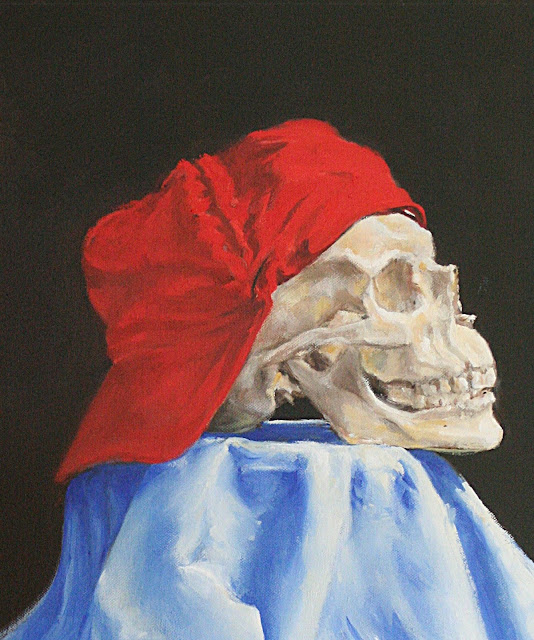When December comes it's time to switch to winter mode--a lot of in-studio work, mostly. That means working up paintings from the sketches collected over the last several months but also means time to sit quietly indoors and really look at a subject. One of the best practices for me is still life. Unlike plein air paintings, still life is a chance to utterly control what one does, from subject to setup to lighting and so on. And still life can contain emotional content, implied narrative, and explore light, color, key, values and so on.
 |
| Hoff, "Vanitas," oil on canvas, 20x16 |
In the vanitas work above I was exploring a number of ideas. For one thing, the pyramidal composition is generally thought to be a positive one since the sweep of vision goes heavenward. For another, it was interesting to employ a three-primary color scheme. Vanitas paintings are generally intended to warn the viewer of universal mortality and warn against excess pride. Early vanitas works, painted three or four hundred years ago, are also often quite dark. The high key of this one is because of a strong light source from the upper right, an intentional effect to emphasize the skull. Another goal of this work was to study the anatomy of the human skull and reproduce it with anatomic accuracy.
Vanitas works are only a small subset of still life in general. Some still life contains enormous numbers of objects, either to imply narrative or perhaps simply as a way to study disparate objects. In my own case I sometimes set up only one or two items. The painting below is an example.
 |
| Hoff, "Transparent and Translucent," oil on panel, 12x9 |
The bottles in Transparent and Translucent were chosen for shape but also because their materials--transparent glass and translucent plastic--are different problems for the painter. And although there is an orange lid and a touch of red in the pimento olive stuffings the dominant color scheme of blue-green was interesting too.
In contrast, my interest in the objects below was the contrast between the red drapery background and the Pellegrino bottle. I had a small silver cup in the studio and plopped it down in front of the bottle to study the reflective metal. The lemon was an afterthought--I didn't have one but wanted the round shape as a contrast, so the lemon is an invention that wasn't in the setup. Part of the intent in this work, too, was to be as loose as possible while being accurate.
 |
| Hoff, "Pellegrino and Silver," oil on panel, 12x9 |
So bring on the ice and snow. I'll be snug in the studio.
No comments:
Post a Comment